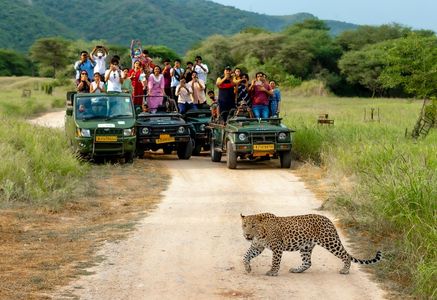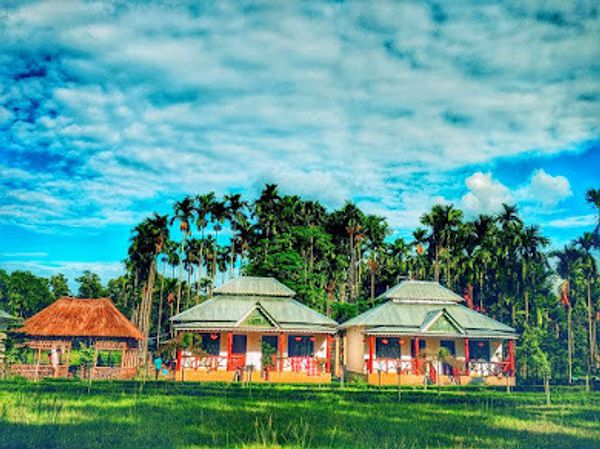Spots in the Shadows: Discover the Wild Charm of Jhalana Leopard Safari
 Palakshi Meharwal
21 Jul, 2025
8 mins read
25
Palakshi Meharwal
21 Jul, 2025
8 mins read
25

Tucked away in the bustling city of Jaipur lies a hidden gem of wilderness—Jhalana Leopard Safari. Known as India's first leopard reserve within a city, this enchanting forest offers visitors a rare opportunity to witness wildlife thriving alongside urban life. With its rocky terrain, dry deciduous forest, and elusive predators, Jhalana has carved a unique space for itself among India's wildlife destinations. This article uncovers the untamed beauty, ecological significance, and visitor experiences that make Jhalana Leopard Safari a must-visit for wildlife enthusiasts and curious travelers alike.
A Forest in the City: The Story Behind Jhalana
Jhalana Safari Park spans roughly 20 square kilometers in the heart of Jaipur, Rajasthan. What makes it extraordinary isn’t just its proximity to city life, but its astonishing leopard population. Despite being a relatively small reserve, it is home to over 30 leopards, including a few dominant females often spotted with their cubs. Historically, a hunting ground during the reign of Jaipur’s royal family, Jhalana was declared a wildlife conservation reserve in 2017, marking a significant step toward urban wildlife preservation.
The transformation from a hunting forest to a conservation hub highlights the broader efforts in India to balance ecological protection with tourism. The Rajasthan Forest Department continues to play a pivotal role in safeguarding the region’s biodiversity, working with local stakeholders and naturalists to ensure responsible tourism practices.
Wildlife Encounters Beyond Leopards
While leopards are undoubtedly the stars of the show, Jhalana’s ecosystem supports a surprisingly rich diversity of wildlife. Safari-goers often spot animals such as desert foxes, Indian palm civets, jungle cats, and striped hyenas. Birdwatchers are also rewarded with sightings of over 150 bird species, including shikras, white-eyed buzzards, peacocks, and Indian pittas—especially during the migratory seasons.
The flora here consists mainly of dry deciduous vegetation, dominated by dhok trees, acacias, and bamboo, which offer natural camouflage for its stealthy residents. This environment not only supports a balanced ecosystem but also makes each safari drive a thrilling game of hide-and-seek with nature.
What to Expect on a Safari
Visitors can explore Jhalana in open 4x4 gypsy vehicles accompanied by experienced guides and forest drivers. The reserve is divided into two safari zones: the Base Zone and the Shikaar Audi Zone, both offering different terrains and vantage points.
Each safari typically lasts for two to three hours, scheduled in two slots per day—morning and afternoon. The best time to visit is during the cooler months between October and March, when wildlife is more active and temperatures are pleasant.
Sightings are frequent, especially of leopards lounging in the shade or gracefully crossing the trail at dawn or dusk. However, patience is essential. Unlike the tiger-centric safaris of Ranthambore, Jhalana offers a quieter, more intimate experience, where the rustle of leaves or distant alarm call can signal a nearby presence.
Responsible Tourism and Conservation Efforts
Jhalana is not just about spotting leopards; it's also a model of how urban spaces can harmonize with wildlife. Strict regulations ensure that vehicle numbers per safari are limited, maintaining ecological balance and minimizing stress on animals. Noise is kept to a minimum, and guides are trained in wildlife behavior, ensuring tourists are educated and respectful.
In recent years, camera traps and GPS collars have helped forest officials monitor leopard movements, understand territorial patterns, and prevent human-wildlife conflict. Such scientific interventions, combined with community awareness programs, have fostered a healthier coexistence between Jaipur’s residents and their wild neighbors.
Tips for Visitors
- Book in Advance: With limited vehicles allowed per slot, it’s advisable to book safaris online through official government portals or trusted tour operators.
- Opt for Morning Safaris: Early hours often increase the chances of leopard sightings, as these nocturnal cats tend to move at dawn.
- Dress Appropriately: Earth-toned clothing and comfortable footwear are ideal. Carry binoculars and a camera with a zoom lens to make the most of your experience.
- Listen to the Guide: Their knowledge of animal behavior, territories, and recent sightings can make all the difference.
- Stay Ethical: Avoid littering, loud noises, or pressuring guides to chase animals. Respect the forest—it is their home, not our playground.
Why Jhalana Stands Out
Unlike national parks that sprawl across hundreds of kilometers, Jhalana provides a compact and accessible safari experience, especially suitable for those on short city visits. Its well-maintained paths, rich wildlife, and enthusiastic naturalists turn a few hours into a deeply immersive experience. Moreover, it challenges the idea that wildlife only exists in remote, protected forests—showing instead that even a city can shelter wild beauty, if given the chance.
For photographers, Jhalana offers raw and untamed visuals—golden grasslands set against the backdrop of Jaipur’s skyline, leopards framed by thickets, and sunsets that bathe the forest in amber hues. It’s not just a safari; it’s a narrative of survival, adaptation, and the seamless dance between nature and urbanity.
Final Thoughts
In a world where concrete often overshadows green, Jhalana Leopard Safari is a bold reminder of nature’s resilience. Its charm lies not just in the spotted cats prowling the underbrush, but in its very existence—a thriving ecosystem right next to the pink city’s chaos. Whether you're a wildlife lover, a curious traveler, or someone looking for a new perspective, Jhalana offers more than just a glimpse into the wild—it offers a story waiting to be discovered.
Written By:
Palakshi Meharwal



Hotels at your convenience
Now choose your stay according to your preference. From finding a place for your dream destination or a mere weekend getaway to business accommodations or brief stay, we have got you covered. Explore hotels as per your mood.


